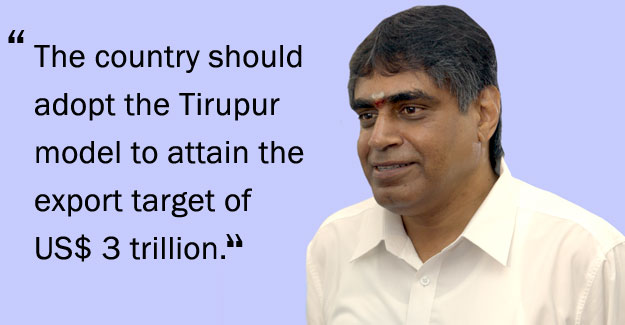
Tirupur’s Unity In Competition Model Can Achieve India’s Export Target Of US$ 3 Trillion
On the sidelines of DyeChem World Exhibition, in early June, in Tirupur, Raja M. Shanmugham, President, Tirupur Exporters’ Association, spoke with Reena Mital, about the Tirupur model of success, presenting compelling reasons to the industry and the government to go the Tirupur way. On the US$ 3 trillion exports target I believe that if we follow the Tirupur model, exports of US$ 3 trillion can be easily achieved. Let me back this statement with some statistics. India’s total exports in the last financial year stood at around US$ 480 billion. Of this, Tirupur accounted for a share of 0.8%. So, US$ 4.56 billion worth of exports were from Tirupur alone. And this, from just one product. What makes this even more interesting is that this was achieved mainly through exports by MSME sector. Tirupur is an epitome of MSME success. So, for me the Tirupur model is – Unity In Competition. We are all competitors here, but we have always come together for the betterment of the industry, for creating and developing the infrastructure of this district. We have 750 districts across the country. If each district can have one cluster like Tirupur, related to their own product of specialisation, attaining US$ 3 trillion exports from the country is not at all difficult. On Tirupur’s sustainability practices We have made marvellous progress in sustainable practices, knowingly or unknowingly. Tirupur’s dyeing and processing units were forced to close down in 2011, due to pollution issues. Today we have adapted very well to the sustainable practices such as zero liquid discharge, out of compulsion maybe, but we are perfectly aligned to sustainability goals. I can say that we were the pioneers in adopting zero liquid discharge, at a time when there was no modern, foolproof solution. We, as an industry amalgated various existing solutions, and evolved ZLD. Today, not a single drop of water is allowed to leave the factory, untreated. Resultant factor is that water conservation has become the main objective of the Tirupur cluster. As much a 10 crore litres of water is being recycled day in and day out. Our process houses here today are used to recycling water to the fullest, reducing the load on ETPs and the environment. Green energy is another focus area for this cluster. The entire Tirupur district consumes around 650 MW of power. What we have done silently is that around 2000 MW of green energy through solar and wind has been established. And it is being connected to the grid. Tirupur continues to evolve and adopt green production practices. On the incessant cotton price fluctuations every season This year especially, cotton prices have been a disturbing factor, in fact, all raw material, input costs have gone up by 100%. It is an unprecedented situation for the industry. We have been urging the government to step in to ensure the industry’s sustainability, as this industry is predominantly in the MSME sector. In Tirupur alone, 95% of the units are MSMEs employing 600,000 workers, and another 200.000-300.000 workers indirectly. If these units go down, bringing them back is a near impossibility, and the government needs to understand the economic repercussions of this. One solution is that the Cotton Corporation of India (CCI) should start to build cotton stocks. At any given time, the agency should have sizeable cotton stocks to create that much needed buffer from price fluctuations. Mills will have access to a ready stock of cotton when they want it. Again, this will be more beneficial for the smaller units, who are not always able to hedge their cotton positions. This according to me is the only long term, viable solution to this price fluctuation that we witness every season. On India as a textile and apparel sourcing destination for the world India has everything it takes to become the world’s leading sourcing destination for textiles and apparel – the complete value chain, skilled labour, cost effective manufacturing, a fast improving infrastructure. According to me, what has been holding us back is the disconnect between the industry and decision makers, which has hampered quick and effective action. My suggestion here is that the existing structure of the export promotion councils should to disbanded, it has proved ineffective, and nothing more than a lobbying platform, where just a few have a voice, instead of the entire industry. Lobbying is a British legacy, a lacuna in our system which needs to be corrected. Instead, there need to be product boards in the happening areas. For instance, knitwear board in Tirupur, home textiles board in Karur, woven fabrics board in Ichalkaranji, or Bhilwara, carpet board in Bhadohi or Kashmir, with industry representations from across the country. Such boards will work towards boosting the sectors, and be able to give a true representation of the industry, allow for quick policy and other interventions when needed. I stress this point again – our textile industry is largely represented by the MSMEs, it is a labour intensive industry, among the largest employment generators in the country. This revamp will make the Indian textile industry truly Atmanirbhar, and a world force.
Textile Excellence
If you wish to Subscribe to Textile Excellence Print Edition, kindly fill in the below form and we shall get back to you with details.








